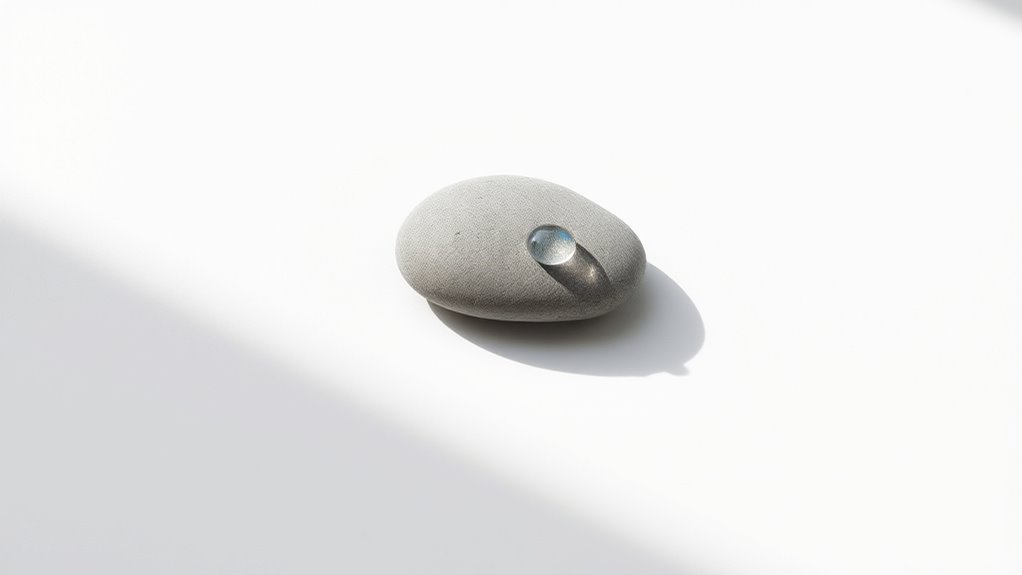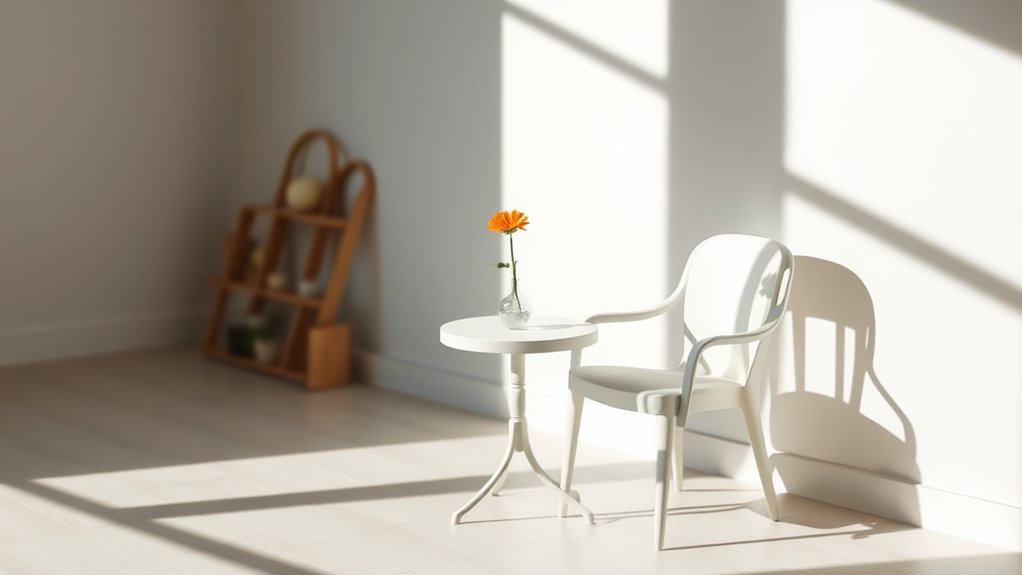To start your minimalist journey, focus on small, intentional steps that lead to big changes. Begin by tackling one task or area each day, which prevents overwhelm and promotes consistent progress. Use the "one-in, one-out" rule for new items and regularly assess your possessions based on need and joy. Embracing mindful consumption will help curb impulse purchases. This approach simplifies your life and enhances your experiences, ensuring you prioritize what truly matters—discover more ways to embrace this mindset.
Key Takeaways
- Begin with a small area to declutter, making the process manageable and less overwhelming.
- Implement the "one-in, one-out" rule to minimize new acquisitions and maintain reduced clutter.
- Focus on one task each day to achieve consistent progress without feeling stressed.
- Reflect on your core values to ensure that your decluttering efforts align with what truly matters in your life.
- Preserve memories through photographs instead of keeping sentimental items to ease the letting go process.
The Power of One: Focusing on One Thing a Day

When it comes to decluttering your life, the "One Thing a Day" rule can be a game changer. By focusing on just one thing each day, you'll avoid feeling overwhelmed and make consistent progress toward living with less.
This approach fits seamlessly into your busy schedule, allowing you to tackle projects of any size. For instance, organizing your entertainment unit could lead to eliminating up to 50% of its contents, enhancing functionality.
This method aligns perfectly with minimalism and intentional living, emphasizing simplicity and focus. Breaking larger goals into manageable tasks keeps you motivated and shows tangible results, transforming your space into a more organized, serene environment. Additionally, understanding brewing methods can enhance your coffee-making experience, making it a mindful daily ritual.
Embrace daily progress, and watch your decluttering journey flourish.
Decluttering Made Easy: Simple Steps to Start

Embracing minimalism starts with taking actionable steps toward decluttering your space. Start small by choosing one area, like a drawer or closet, to make the process manageable. Use the "one-in, one-out" rule to help you own less and maintain a clutter-free environment. Assess each item by asking if it's liked, needed, or used regularly. Letting go of things that don't meet these criteria can be liberating.
Here's a simple action plan:
| Step | Action |
|---|---|
| Identify an area | Choose a drawer or closet |
| Make decisions | Keep only important things |
| Schedule sessions | Declutter daily or weekly |
| Start one at a time | Focus on easy items first |
| Take action | Donate, toss, or recycle |
These steps will set you on the path to minimalist living!
Mindful Consumption: Reducing New Acquisitions

Mindful consumption is the cornerstone of a clutter-free life, guiding you to assess the necessity and value of items before making purchases.
By focusing on intentional purchases, you can embrace a minimalist lifestyle that promotes owning less and reducing new acquisitions.
Consider these strategies:
- Adopt a "one-in, one-out" rule: For every new item you bring home, let go of an existing one.
- Keep a shopping list: This helps avoid impulse buys and guarantees you're only acquiring essentials.
- Reflect on your motivations: Understanding why you want something can lead to more meaningful, high-quality items. Additionally, being aware of consumer awareness can help you make informed decisions about your purchases.
Prioritizing What Matters: Identifying Core Values

How can you truly prioritize what matters in your life? Start by identifying your core values, as they serve as a guiding compass for your decisions and lifestyle choices.
Reflect on what brings you joy and fulfillment—whether it's relationships, health, creativity, or sustainability. This process helps you assess your current commitments, enabling you to eliminate those that don't align with your authentic self.
By understanding your core values, you can embrace intentional living, focusing on meaningful experiences rather than material possessions. Additionally, establishing a solid support network for new fathers can enhance your journey towards minimalism by providing encouragement and accountability.
Regularly revisiting these values fosters clarity and purpose, empowering you to make thoughtful choices on your minimalist journey.
Prioritize what truly matters, and you'll discover a more fulfilling life.
Overcoming Emotional Attachments: Letting Go of Sentimental Items

Let's face it: letting go of sentimental items can be tough because of the emotional ties you have to them. However, understanding these attachments and using practical strategies can make the process easier. Embracing mindfulness practices can enhance awareness and reduce anxiety during the decluttering journey.
Understanding Emotional Attachments
Why do we hold onto sentimental items, even when they weigh us down?
Emotional attachments often stem from the memories tied to these objects, making letting go a challenge. To embrace a more intentional approach to decluttering, consider the following:
- Acknowledge your feelings: It's normal to feel sadness when parting with cherished items. Allowing yourself to grieve fosters self-compassion.
- Recognize your identity: Understand that your possessions don't define who you are. This realization helps lighten the emotional weight of items.
- Preserve memories differently: Take photographs of sentimental items to keep the memories alive without the physical burden.
- Practice mindfulness: Engaging in mindfulness techniques can enhance your present-moment awareness, making the process of letting go easier and more fulfilling.
Strategies for Letting Go
Letting go of sentimental items can feel intimidating, but with effective strategies, you can navigate this emotional journey.
The first step is to establish a limit—designate a box or shelf for your sentimental items. This helps you manage how much stuff you keep and encourages mindful selection.
Reflect on the purpose of each item: does it enhance your life or just occupy space? Taking photos of these physical stuff can preserve memories without the burden of keeping them.
Engage in conversations with supportive friends or family members; they can offer perspective and help alleviate guilt. Additionally, recognizing the importance of empathy during this process can help you understand that letting go is a form of self-care.
Building a Minimalist Mindset: Embracing Change in Daily Life

As you begin to embrace a minimalist mindset, you'll find that re-evaluating your priorities can lead to a more intentional and fulfilling life.
You'll spend less time feeling overwhelmed by clutter and more time enjoying what truly matters. Here are three strategies to help you cultivate this mindset:
- Start Small: Commit to decluttering one item or organizing one space each day. This simple act creates a sense of accomplishment and motivates you to keep going.
- Practice Mindfulness: Focus on gratitude and appreciate what you have, shifting away from consumerist habits.
- One-in, One-out Rule: For every new item you bring in, remove an existing one to maintain a clutter-free environment and create a life of simplicity. Additionally, incorporating mindful decluttering strategies can further enhance your journey toward minimalism.
Frequently Asked Questions
What Is the 90/10 Rule of Minimalism?
The 90/10 Rule of minimalism suggests that 90% of your happiness comes from just 10% of your possessions and experiences.
It encourages you to identify and prioritize what truly matters in your life. By focusing on this small percentage, you can declutter the 90% that doesn't contribute to your joy.
This approach helps you embrace a more intentional lifestyle, making choices based on value and meaning rather than getting lost in excess.
What Is the 30 Day Rule for Minimalism?
Imagine you're peeling an onion, layer by layer.
The 30 Day Rule for minimalism works similarly. Each day, you'll declutter one more item than the day before—starting with one on day one and ending with thirty on day thirty.
What Is the One Thing a Day Rule?
The One Thing a Day Rule is all about tackling one small decluttering or organizing project each day.
You pick a task that fits your schedule, whether it's organizing a drawer or decluttering a room. By focusing on just one project daily, you avoid feeling overwhelmed and build a sense of accomplishment.
Finishing a task before starting another keeps you engaged and helps you steadily create a more organized living space.
What Is the Theory of Minimalism?
The theory of minimalism focuses on intentional living by stripping away excess.
You're encouraged to question what you truly need, allowing you to prioritize what brings you joy and fulfillment.
By reducing physical and mental clutter, you create space for clarity and creativity.
This approach not only simplifies your environment but also enhances your overall well-being.
Embracing minimalism can lead to less stress and a more balanced, meaningful life.
Conclusion
Embracing minimalism can transform your life in ways you never imagined. Envision this: Sarah, overwhelmed by clutter, decided to tackle one small area of her home each day. Within weeks, she felt lighter and more focused. By prioritizing her core values and letting go of sentimental items, she rediscovered joy in her surroundings. You can start your own journey today—commit to one small change, and watch how it leads to a bigger, more fulfilling life.









